
 |
 |
 |
 |
 |
 |
 |
email: roadarch@outlook.com |
 |
| Opal Glass Signs (page 1) |
(hit "refresh" to get the most recent version of this page; click on photos for larger images)
| The photos and links at these two pages are meant to accompany an article that I wrote for the Society for Commercial Archeology's Journal. |
|
Opal glass signs were built from the 1910s through the 1930s. The letters were made of translucent glass and backlit with light bulbs inside the sign. Many people refer to these letters as "milk glass" since the majority of them were white. However, other colors were produced as well. The Opalite Sign Company, one of the largest manufacturers of these signs, made letters in white, blue, orange, red, green, and two shades of yellow. Opal glass letters also came in a variety of sizes and typefaces. The Charles Sign Company of Chicago bragged in an advertisement of having 33 alphabets in stock. The Flexlume Sign Corporation produced 80 alphabets. Based on vintage photos and surviving signs, the most popular typeface appears to have been Copperplate Gothic. Some sign companies also produced opal glass shapes such as arrows, stars, pointing hands, and mortar and pestle designs.
Each of these letters was produced on a separate plate and installed inside the sign. The faces of the sheet metal sign cabinets were perforated to allow the raised letter shapes to protrude. These letters had a couple of distinct advantages over flat painted signs. The wording could be read at an angle by pedestrians and motorists. In addition, the brightness of the letters increased the sign's visibility. These signs were produced for businesses of all kinds and sizes. They advertised for car dealerships, dentists, jewelry stores, hardware stores, gas stations, and restaurants. They appeared at subway entrances. Banks, hotels, and office buildings also used interior, small-scale opal glass letter signs for teller windows, elevators, and directional signs. Department stores used the changeable letters for message boards. Theatres used the letters on marquees to announce titles and showtimes. Movie theatres continue this method of advertising today but with plastic letters instead of glass. The majority of opal glass signs were custom built for individual businesses. However, there were production signs made as well for the Gulf Oil Company and chain stores. In the mid-1920s, sign companies were enthusiastically promoting opal glass signs. However, all of that was about to change. Neon was introduced in the late 1920s. By the mid-1930s, production of opal glass signs had all but ceased. Over time, most business owners scrapped their glass letter and bulb signs, replacing them with new neon signs. Some businesses simply added neon borders to their signs. Other signs were updated with neon tubing installed directly over the glass letters. Only a few dozen of these opal glass signs remain on display across the country. The majority of them are not maintained and only a few are still lit. Many of them have broken or missing letters. Some businesses replaced these letters with white plastic sheeting inside the sign cabinet. This low-cost fix made the sign's characters at least readable and has kept these early signs still hanging. Glass letters are rarely produced any more. The Flexlume Sign Corp. in Buffalo, NY is possibly the inventor of these signs. The company began producing them between 1904 and 1910 at their original location in Canada. Up until the owner's passing in 2017, Flexlume still made these letters using the original technique to create replacement letters for collectors and businesses. Those molds are gone now. To create each letter, a separate, heat-resistant mold needs to be produced. A sheet of glass is then placed over the mold. When heated in a kiln, this glass melts or "slumps" over the mold. Opal glass letters are sometimes referred to as "slump glass" because of this process. Some companies produced glass letters by pressing the glass into molds. This video shows one of the ways that these letters can be made. The signs in this section are organized alphabetically by state. |
| Montgomery Shoe Factory Montgomery, AL |
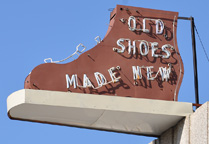 |
|
The Montgomery Shoe Factory sign was updated at least once with neon. There are two types of housings for the tubing. It appears that the neon border and arrows over the bootís laces were either part of the original sign construction or they were later additions. At some point later on, the neon was applied over the signís glass letters. This is the only opal glass sign known to still exist that was built in the shape of something.
NewSouth Books owns the building and occupies the retail space below the Montgomery sign. Around 2007, the owner stabilized the sign and repainted it with brown, rust-inhibiting paint. It was previously painted a light olive green. The switch for the sign is difficult to get to so it is usually left on all the time. However, only a few of the white neon letters are still lit. The owner plans to restore the sign at some point. He is considering changing the neon "Shoes" lettering to "South". If the cost is not too high, he may have the opal glass letters relit as well. A flashing mechanism would allow the neon "South" to turn on and off, revealing the "Shoes" letters underneath. [map] |
|
More Alabama:
Alabama Power Company (Greensboro) [vintage; gone] Arkansas:
|
| Bisbee Review Bisbee, AZ |
|
 |
 |
| The Bisbee Review newspaper was published from 1901-1971. I believe the paper's offices were located here. [map] |
| Hotel Monte Vista Flagstaff, AZ |
||
| 2012: | 2017: | |
 |
 |
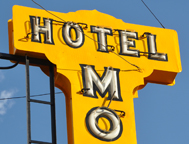 |
| The Hotel Monte Vista was built in 1926 and the sign is most likely from then. This sign also features ripple tin panels which was commonly used for signs of this era. The material was lighter than steel and strengthened by the grooved treatment. The ripples also held paint longer than a smooth surface. It is not known when the neon was installed over the glass letters of the Monte Vista sign. The letters are no longer backlit but the red neon is well-maintained. The panels were painted gold around 2016. The hotel also has a couple of neon signs. For more, see this website. [map] |
| San Carlos Apartments Tucson, AZ |
||||
| 2012: | 2017: | |||
 |
 |
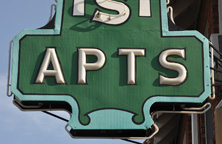 |
 |
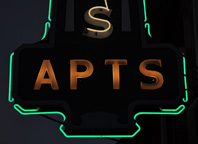 |
| The San Carlos Apartments were built in stages: in 1880, 1910, and 1920. This sign is probably from around 1930. The panels are made of ripple tin. Most likely, this was always a combination sign of neon and opal glass letters. The "San Carlos" was probably composed of raised neon letters affixed to the sign like the Hotel San Carlos sign in Yuma shown below. This sign was restored in 2013. However, the "SAN" at the top was not lit in 2017. [map] |
| Hotel San Carlos Yuma, AZ |
Hotel Del Sol Yuma, AZ |
||||
 |
 |
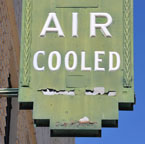 |
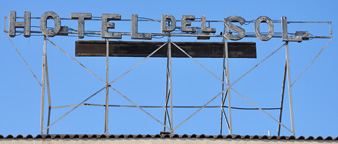 |
 |
 |
|
The Hotel San Carlos was built in 1930 and this sign is probably from then. The "Air Cooled" letters at the bottom of this sign are made of opal glass. The neon on the hotel's signs was restored in 2013 but the opal letters are not lit. For more about the building, see this page.
The Hotel San Carlos' sign faces are made of "ripple tin" which has a rippled texture. Although this sign has been repainted a number of times, the patterning is still visible. This crimping process was not just decorative. It straightened the faces of the sign after the holes had been cut for the letters. Ripple tin signs also held paint better than a flat sign and enabled the sign maker to use lighter metal. This material was popular during the opal glass sign era and was used with many other signs shown on this page including the Hotel Monte Vista sign shown above. [map] The Hotel Del Sol was built in 1926 as the Del Ming Hotel. The name was changed to the Hotel Del Sol in 1936. It has been vacant since 1981. The city now owns the building and hopes to restore and convert it into a transportation center someday. The opal glass sign is probably from the 1930s. Neon was installed on top of the letters later on. That tubing is now mostly gone. The rooftop neon sign was here by the 1940s. Originally, there was another row of text on top of the sign which spelled out "New". There was also a Nite Club sign on the building which was restored and relocated. That sign is gone now. For more, see this website. [map] |
| Bradbury Building Los Angeles, CA |
Hotel Bixby Los Angeles, CA |
Belasco Theatre Los Angeles, CA |
||
 |
 |
 |
 |
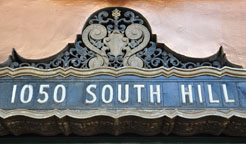 |
|
The Bradbury Building was built in 1893. The sign is probably from the 1910s or 1920s. For more, see this website. [map]
The Hotel Bixby was built in 1911. This sign features hinged letter plates. This made it easier to replace the light bulbs inside the sign. [map] This address sign from the Belasco Theatre features interchangeable opal letters. The theatre opened in 1926. It is now used as a performing arts venue. [map] |
| Manning's Coffee Store Los Angeles, CA |
|||||
| 2012: | 2019: |
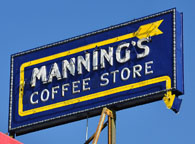 |
 |
|
The Manning's Coffee Store sign was built in 1933 during the waning years of opal glass letters. The arrow and "Manning's" raised letters were lit with neon. The "Coffee Store" glass letters were secondary features. The border detail was a typical element for early pre-neon signs. Sign companies carried stock designs which were usually made of tin. These border pieces were cut to size and soldered onto signs.
The Manning's restaurant chain originated in Seattle and expanded throughout the western United States. At one time, there were 19 locations in Los Angeles. This sign was originally installed in Hollywood, California. It was moved to this Highland Park location in 1936. After the restaurant closed in the 1950s, the sign fell into disrepair. The opal glass letters were stolen in the 1990s but were later recovered. In 2011, the sign was meticulously restored and relit with funding from the National Trust and the National Park Service Route 66 Corridor Preservation Program. The paint has faded considerably since then. For more, see these websites: 1 and 2. [map] |
| Jensen's Recreation Center Los Angeles, CA 2013: |
||
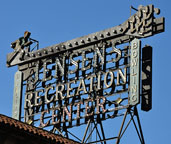 |
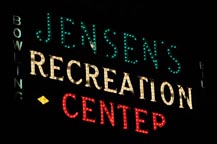 |
 |
| 2017: | |
 |
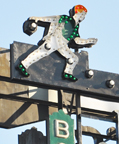 |
| Jensen's Recreation Center was built in 1924. This rooftop sign was erected then or shortly thereafter. It is 28 feet long and 17 feet tall. There are an estimated 1,300 red, green, and white bulbs. The building originally had a bowling alley and pool hall. The man at the top of the sign bowls a strike with bulbs lit in sequence into dancing pins. The letters in the center of the sign are also lit sequentially. The signs on the sides of the sign have backlit opal glass letters. The sign was restored and relit in 1997. The building was sold in 2014. The sign was restored again in 2017. It was repainted and all of the bulbs and internal components were replaced. This is the last surviving, and operating, animated bulb sign in the country. For more, see these websites: 1, 2, 3, 4, and 5. [map] |
| Capulet Apartments Los Angeles, CA |
Vivian Apartments Los Angeles, CA |
Curzon Lodge West Hollywood, CA |
|
 |
 |
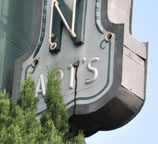 |
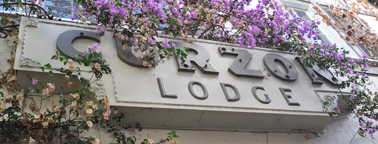 |
|
The Capulet Apartments were built in 1917. This single-sided sign is probably installed then or shortly after that. [map]
The Vivian Apartments were built in 1928 and this sign is probably from then. It features both neon and opal glass letters. [map] The Curzon Lodge apartment building was built in the late 1910s or early 1920s. This sign with opal glass letters at the bottom is probably from then. It is located on the side of the building. [map] |
|
Opal Glass Signs page 2 |
Opal Glass Signs page 3 |
Opal Glass Signs page 4 |
Opal Glass Signs page 5 |
Main SCA Article Companion Page |
Main Signs Page |
| RoadsideArchitecture.com |
Copyright. All photos at this website are copyrighted and may only be used with my consent. This includes posting them at Facebook, Pinterest, blogs, other websites, personal use, etc. Tips & Updates. If you have suggestions about places that I haven't covered, historical info, or updates about places/things that have been remodeled or removed, I'd love to hear from you: roadarch@outlook.com. |